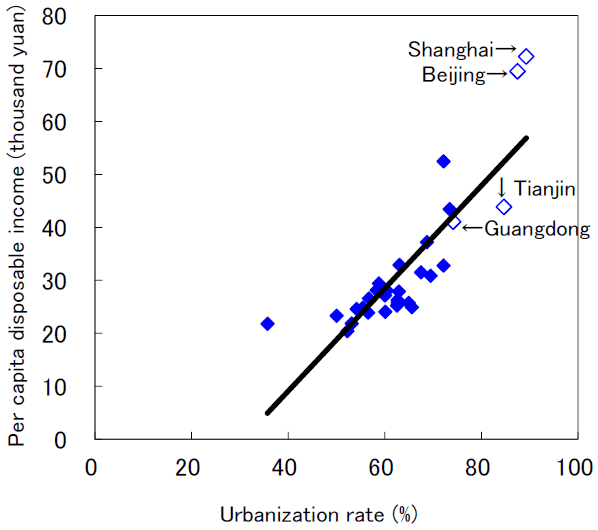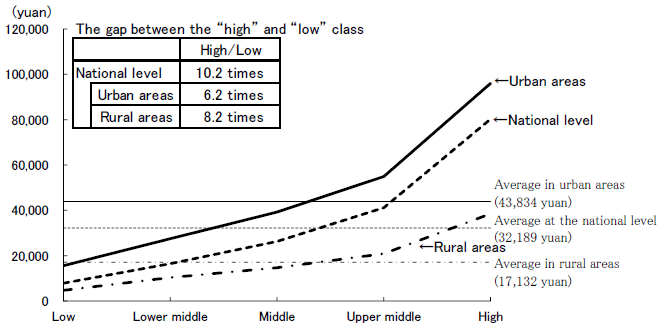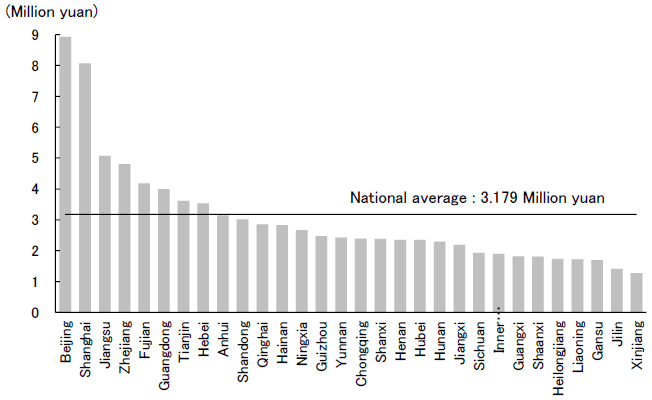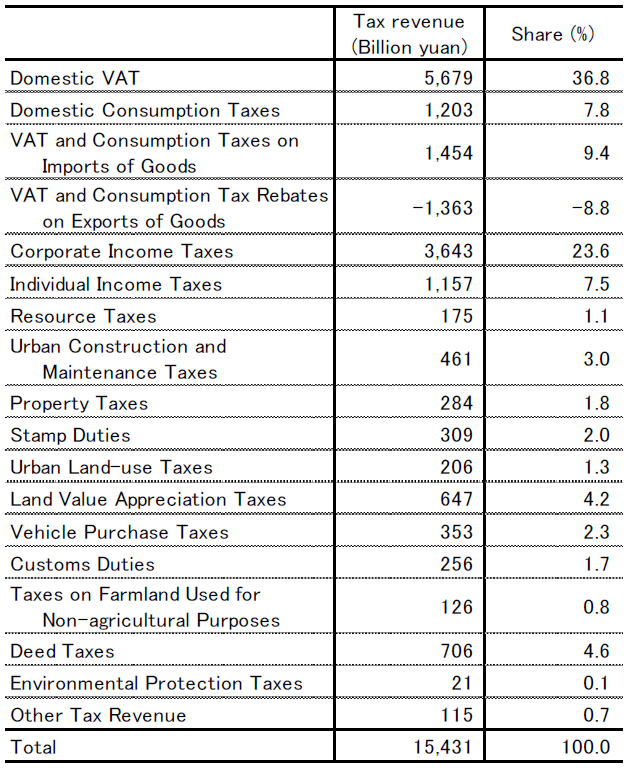Ⅰ. From the "Get Rich First Policy" to "Common Prosperity"
In order to overcome the negative effects of the egalitarianism of the planned economy era, Deng Xiaoping promoted a reform and opening-up policy that prioritized efficiency over equality under the banner of "getting rich first" (Box 1). 40 years or so later, the lives of the people have generally improved, but the income gap has widened. The Xi Jinping administration, which came into power after the 18th National Congress of the Communist Party of China (CPC) in November 2012, with the aim of rectifying the disparity, has put "common prosperity" at the forefront of its economic development goals.
Under his administration, China has lifted its entire poor population, about 100 million people, out of poverty, and realized the poverty reduction targets of the United Nations' 2030 Agenda for Sustainable Development ten years ahead of schedule. However, the three disparities between urban and rural areas, between regions, and between different income groups remain large. The disparity between urban and rural areas is the cause of the other two disparities, and therefore, raising rural incomes has become a top priority for the government (Note 1).
At the 10th meeting of the Central Finance and Economic Commission of the Communist Party of China (CPC), presided over by General Secretary Xi Jinping on August 17, 2021, it was stated that "common prosperity is an essential requirement of socialism and a key feature of Chinese-style modernization" and that "the focus of promoting people's well-being should be put on boosting common prosperity to strengthen the foundation for the Party's long-term governance." In order to realize such common prosperity, it was emphasized that the role of market-led "primary distribution," government-led "secondary distribution," and "tertiary distribution" focused on morality (private donations and public welfare projects). In particular, there are high expectations for the strengthening of "secondary distribution" through fiscal and social security reforms.
The conference identified the following six issues that need to be addressed in order to achieve common prosperity (Note 2).
(1) Increase equality, cooperation, and inclusiveness in development.
- Accelerate the development of a socialist market economy system.
- Enhance the equality of regional development.
- Strengthen the coordination of development among industries.
- Support the development of small and medium-sized enterprises.
(2) Focus on expanding the scale of the middle-income population.
- The support should be targeted at university graduates, technical workers, small and medium-sized business owners and sole proprietors, and migrant farmers who have moved to cities.
(3) Promote equalization of basic public services.
- Focus on inclusive human capital investment and establish systems for elderly care and medical security, a relief system to support the poorest, and a system for housing supply and security.
(4) Strengthen norms and adjustments for high-income earners.
- We will protect legitimate income in accordance with the law, reasonably regulate excessively high-income earners, improve personal income taxation, and promote real estate tax legislation and reform.
- Encourage high-income groups and enterprises to contribute to society through public charity. Organize and standardize unreasonable incomes, set up an orderly income distribution system, and firmly crack down on illegal incomes.
- Protect property rights and intellectual property rights, protect legitimate enrichment, and promote sound development in accordance with the norms of various types of capital.
(5) Promote the common prosperity of people while meeting their spiritual needs.
- Enhance direction based on socialist core values, and continuously meet the diverse spiritual and cultural needs of the masses (Note 3).
- Strengthen public support for common prosperity and provide a favorable public opinion environment for its promotion.
(6) Promote the common prosperity of farmers and rural communities.
- Consolidate and expand the results of the efforts so far to lift people out of poverty.
- Fully promote rural development, strengthen the construction of rural infrastructure and public service systems, and improve the living environment.
Ⅱ. Rectifying the Urban-Rural Gap Is a Challenge
Despite the ideology of socialism espoused by the government, China has one of the largest disparities between the rich and the poor in the world, with incomes in rural areas far below those in urban areas. In order to increase rural incomes, the key is to promote rural development and grant urban household registration to migrant farmers.
1. The Gap between Urban and Rural Areas Remains Large
In 2020, per capita disposable income in China reached 32,189 yuan nationwide, but the level is only 17,132 yuan in rural areas, 39.1% of the 43,834 yuan in urban areas (Note 4).
The income disparity between urban and rural areas is also a major source of regional disparity and class disparity. In fact, the more urbanized regions (provinces, autonomous regions, and centrally administered municipalities) tend to have higher per capita disposable income (Figure 1). Looking at the disparity in per capita disposable income among the different classes, the ratio of "high" to "low" among the five classes of "high," "upper middle" "middle," "lower middle," and "low," which each account for 20% of the total number of households, is 10.2 times for the nation as a whole in 2020, higher than 6.2 times for urban areas and 8.2 times for rural areas. (Figure 2).


In China, the asset gap is even larger than the income gap. According to a survey report compiled by the Household Assets and Liabilities Survey Team of the People's Bank of China's Statistics Office, the average assets owned by urban households in China amounted to RMB 3,179,000, in 2019 with housing accounting for nearly 60% of the total, and the home ownership rate reaching 96.0%. Mainly reflecting the difference in housing prices, the average asset values per household in urban areas by region (province, autonomous region, or centrally administered municipality) amounted to 8,928,000 yuan in Beijing, the highest, but only 1,275,000 yuan in Xinjiang, the lowest (Figure 3). Although reliable data on household assets are not available for rural areas, the asset gap between urban and rural areas is likely to be even larger than the urban-rural income gap, given that the resale of housing is strictly regulated in rural areas and housing prices are much lower than in urban areas.

2. Urgent Need for Rural Development and the Granting of Urban Household Registration to Migrant Farmers
China is taking measures to reduce the disparity between urban and rural areas in its 14th Five-Year Plan (2021-2025), focusing on rural development and granting urban household registration to migrant farmers.
First of all, with regard to rural development, the second contracting period of the rural land contracting system, which will expire in the mid-2020s, will be extended for another 30 years, and the default policy of facilitating the transfer of management rights to third parties through the reform of the separation of the three rights of ownership, contracting, and management of farmland has been confirmed. This will make it possible to utilize the farmland left behind in rural areas by farmers who have gone to work in urban areas, and to consolidate land for large-scale farming. Farmers will also be able to earn income from rentals.
At the same time, it aims to accelerate the speed of granting urban household registration to migrant farmers and the migration from rural to urban areas, and to raise the urbanization rate to 65% by 2025. To achieve this goal, the government will reform the household registration system, relax the restrictions on migration based on the household registration system except in the cases of certain large cities, and experiment with a household registration system based on current addresses. In addition, a system will be developed to connect fiscal transfers from the central government to local governments, and the size of newly assigned land for construction in urban areas with the ratio of those granted with urban household registration among the migrant population from rural areas, and basic public services for the new urban residents will be strengthened. In addition, for former farmers who have migrated to urban areas, we will guarantee the rights to contract farmland, use land for housing, and share collective profits, and develop a related system to transfer these rights for compensation through the market.
By removing barriers that constrain labor mobility, such as household registration, the movement of labor between regions and the equalization of wage levels will be promoted. In addition to this, remittances from migrant farmers to their families will be another factor in reducing regional disparities.
Ⅲ. Fiscal and Social Security Reform for Common Prosperity
The income redistribution functions of public finance and the social security system must both be strengthened to achieve the goal of common prosperity.
1. Fiscal Reform
In order for public finance to serve an adequate income redistribution function, reforms in both revenue and expenditure are required.
In terms of fiscal revenue, indirect taxes levied at the consumption stage, such as value-added tax and consumption tax (on luxury goods and tobacco products), are the main source of revenue, and direct taxes on income and assets have low weight (Figure 4). Since the tax burdens associated with these taxes are regressive in the former and progressive in the latter, the current tax system with its low direct ratio does not sufficiently serve the function of redistributing income. In order to change this, the ratio of direct taxes to indirect tax revenue must be increased by strengthening the taxation of income and assets.

First, the proportion of direct taxes must be gradually increased. This can be achieved by reducing the proportion and types of indirect taxes on goods and services, such as value-added tax and consumption tax on one hand, and gradually increasing the proportion of direct taxes, such as corporate tax and personal income tax on the other hand. With regard to personal income tax, comprehensive taxation should be increased. Currently, salary income and other income, such as dividends, are taxed separately in the individual income tax system. Salary income is taxed at a progressive rate, while dividends are taxed at a flat rate of 20%. In addition, capital gains from the sale of stocks and the sale of one's own residence held for more than five years are not subject to taxation. These tax benefits, which favor high-income earners, should be changed. In addition, the tax rate for the wealthy must be raised, while the tax burden on the middle- and lower-income groups must be reduced by raising the level of the minimum taxable income of the personal income tax and by lowering the tax rate for the middle class.
Next, asset taxation should be strengthened through real estate tax reform and other measures (Box 2). At present, China's real estate taxation is limited to business property. Although the direction of reform is set to expand this to include privately owned non-business residences, there are many requests for exemptions to be granted for owner-occupied residences and for residences with less than a certain (per capita) living area. In addition to real estate tax reform, the introduction of inheritance and gift taxes needs to be seriously considered in order to reduce the excessive concentration of wealth.
In addition, normative tax collection practices should be promoted. In order to prevent tax evasion, including failure to report income, it is necessary to establish a personal information system that unifies social security, tax records, and property registration to cover the income, assets, and transaction status of all citizens subject to taxation. A system of real-name registration of financial assets should be implemented in a phased manner, and supervision and control of the income and assets of the super-rich should be strengthened. Efforts must be made to combat corruption and crack down on illegal income.
On the other hand, in terms of fiscal expenditures, the government needs to optimize the direction and structure of the use of fiscal revenue, promote equalization of basic public services, and strengthen fiscal transfers.
First, regarding the optimization of the direction and structure of the use of fiscal revenue, on the one hand, economic construction- and production-related subsidies should be cut, while on the other, more funding should be provided to improve people's lives and enhance people's welfare, focusing on childcare, education, health, housing, and support for the disabled.
With regard to the promotion of equalization of public services, the disparities in level and quality between urban and rural areas, between urban and rural households, and between regions, must be corrected. The Fourteenth Five-Year Plan presents a schedule to "significantly improve the level of equalization of basic public services" by 2025 and "achieve equalization of basic public services" by 2035.
Furthermore, with regard to strengthening fiscal transfers, the government must transfer a larger portion of the tax revenues collected from high-income areas to low-income areas in order to reduce regional disparities. Fiscal transfers also have a significant role to play in rural development.
2. Social Security System Reform
Although the social security system is part of the fiscal system, the "social security fund budget," which is the budget for the allocation of social security revenues (insurance premiums and fiscal subsidies) and expenditures, is a separate account from the "public finance budget." The core of the social security system in China is the basic old-age (pension) insurance system and the basic medical insurance system. Both of these systems are classified into two major categories based on the household registration (urban or rural) of the individual and whether or not they are employed. Specifically, urban employees (including civil servants and the self-employed) are covered by the "Urban Employee Basic Endowment Insurance" (hereinafter referred to as "Employee Endowment Insurance") and the "Urban Employee Basic Medical Insurance" (hereinafter referred to as "Employee Medical Insurance"), while rural residents and non-working urban residents (collectively referred to as "residents") are covered by the "Urban Rural Resident Basic Endowment Insurance" (hereinafter referred to as "Resident Endowment Insurance") and the "Urban Rural Resident Basic Medical Insurance" (hereinafter referred to as "Resident Medical Insurance").
In 2020, the per capita benefit of employee endowment insurance was 40,198 yuan, while that for "residents" was only 2,088 yuan. There is a difference of about 20 times between the two. The per capita medical insurance benefit for "employees" is 3,734 yuan, much higher than the 803 yuan for "residents" (Figure 5). In addition to the disparity between "employees" and "residents" in social security, there is also a large disparity between regions. In particular, in the case of Resident Endowment Insurance, the highest per capita benefit in Shanghai (RMB 16,061) is 12.0 times higher than the lowest per capita benefit in Guizhou (RMB 1,339). In the case of Resident Medical Insurance, the highest benefit cost in Shanghai (2,300 yuan) is 6.2 times higher than the lowest in Tibet (373 yuan) (Note 5).

To achieve common prosperity, disparities in benefits in endowment and medical insurance between "employees" and "residents," as well as between regions, must be reduced as part of social security reform. This will have to be financed by increased fiscal subsidies.
Ⅳ. Challenges That Must Be Overcome
China aims to achieve common prosperity by the middle of this century through raising rural incomes and enacting secondary distribution reforms. On this path, the following challenges lie ahead.
First, resistance from vested interests is expected. In any country, reform is a difficult process. Reforms may increase efficiency and increase the size of the overall economic pie, but they do not always do so. This is because these benefits are not always distributed evenly, and while some people make gains, others lose. Even if the people concerned support the reform in principle, when it comes to the specifics, some people who will suffer losses as a result will oppose it. The failure to introduce inheritance tax and real estate tax to this point in China is a good example of this. Reforms aimed at achieving common prosperity will make it even more difficult to reconcile the different interests as the importance of income redistribution is highlighted.
Also, in the process of economic development, there is a trade-off between growth (efficiency) and distribution (equality). In order to achieve common prosperity, growth must be sacrificed to a certain degree. As a result of the Chinese economy's emphasis on efficiency rather than equality, it has achieved high growth, but at the same time, inequality has increased. In the future, by emphasizing equality over efficiency, growth will slow while inequality shrinks. Excessive redistributive policies should be avoided as they may discourage people from working and investing, leading to economic stagnation and "common poverty."
In order to overcome these challenges and achieve the goal of common prosperity, it is necessary to strike a balance between efficiency and equality in the management of policy, coordinating the interests of all classes under fair and transparent rules, while maximizing the vitality of the market.
BOX1 Deng Xiaoping's Roadmap to Common Prosperity
Deng Xiaoping's famous slogan of allowing some people and some regions to get rich first is only one part of the "common prosperity" argument that aims to "make some people and some regions rich first so that they can eventually become rich together. In fact, Deng Xiaoping made the following statement about the path from "getting rich first" to "common prosperity" in his "Southern Tour Speech" during his tour of Hubei, Guangdong, Shanghai and other southern regions in early 1992.
Where conditions permit, some areas may develop faster than others; those that develop faster can help promote the progress of those that lag behind, until all become prosperous. If the rich keep getting richer and the poor poorer, polarization will emerge. The socialist system must and can avoid polarization. One way is for the areas that become prosperous first to support the poor ones by paying more taxes or turning in more profits to the state. Of course, this should not be done too soon. At present, we don't want to dampen the vitality of the developed areas or encourage the practice of having everyone "eat from the same big pot". We should study when to raise this question and how to settle it. I can imagine that the right time might be the end of this century, when our people are living a fairly comfortable life. At that time, while developed areas continue to grow, they should also give strong support to less developed areas by paying more taxes, turning in more profits and transferring technology. Most of the less developed areas are rich in resources and have great potential for development. In short, taking the country as whole, I am confident that we can gradually bridge the gap between coastal and inland areas.
(Deng Xiaoping, "Excerpts from Talks Given in Wuchang, Shenzhen, Zhuhai and Shanghai.," Selected Works of Deng Xiaoping Vol. 3, People's Publishing House, 1993.
BOX2 Real Estate Tax Reform Gathering Momentum
In China, real estate tax reform is under consideration, focusing on extending the scope of taxation to housing in order to curb real estate speculation and the resulting surge in housing prices. Trials have been conducted in Shanghai and Chongqing since 2011. For households with local registrations, the tax applies to newly purchased second and subsequent homes per household in Shanghai, and to single-family private homes and newly purchased private luxury homes in Chongqing. In both Shanghai and Chongqing, the scope of taxation is much broader for households without a local household registration.
Based on this experience, the Standing Committee of the National People's Congress held on October 23, 2021, decided to introduce a new trial real estate tax in some areas. In addition to conventional business real estate, the real estate tax will be levied on privately owned non-business residences (neither of which include rural areas). The person who has the right to use the land (the owner of the house) will be the taxpayer. The cities to be covered by the trial, the tax rate, and the range of properties that can be exempted are still under consideration, but after the trial, the new real estate tax system is expected to eventually be implemented nationwide.
As a direct tax, the real estate tax is difficult to pass on and is effective as a means of adjusting income distribution, as high-income earners pay more, and low-income earners pay less. In implementing the tax, the income redistribution function can be further demonstrated if housing with a living area below a certain level (per capita) is excluded from the taxation, or if a higher tax rate is applied to properties used for investment purposes than to properties used for personal residence.
Until now, local governments have relied heavily on the "land transfer revenue" that they receive when they transfer the time-limited use rights of state-owned land (70 years for residential land, 50 years for industrial land, and 40 years for commercial land). However, this income is limited by the supply of new government-owned land and is largely dependent on the real estate market. In contrast, the new real estate tax system is expected to include existing real estate in the tax base, providing local governments with a more stable and sustainable source of revenue.
The full introduction of a real estate tax on residential properties will curb demand through higher costs associated with home ownership and lower rates of return on investment properties. On the other hand, owners who are holding their homes vacant in anticipation of higher prices will rush to sell their properties to avoid the new tax burden. As a result, housing prices in major cities, which have already reached bubble levels in terms of the ratio of housing prices to household income, will return to more reasonable levels.
The original text in Japanese was posted on January 5, 2022.


